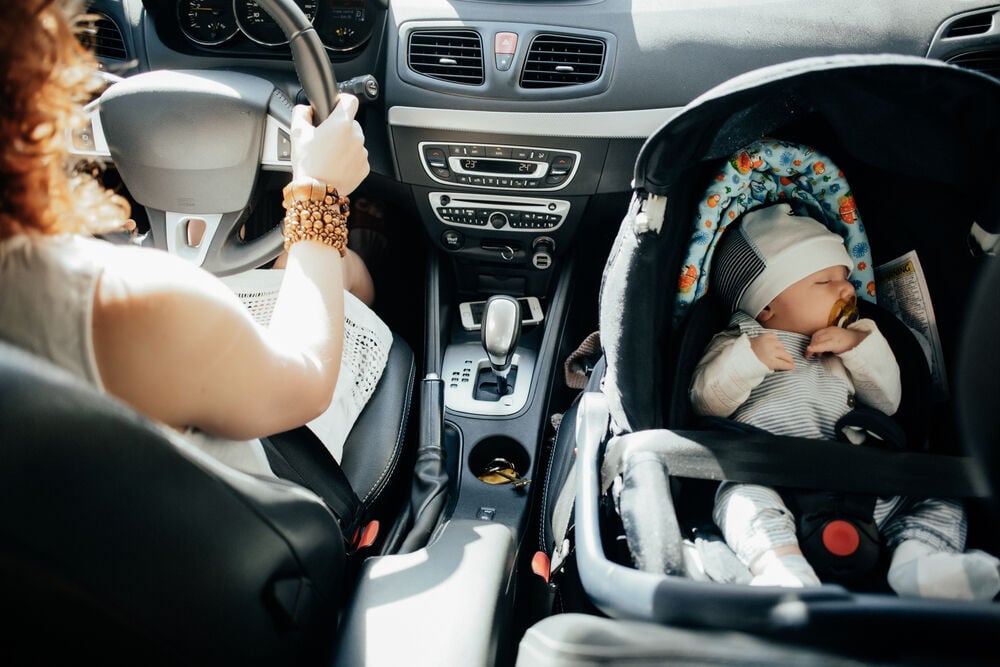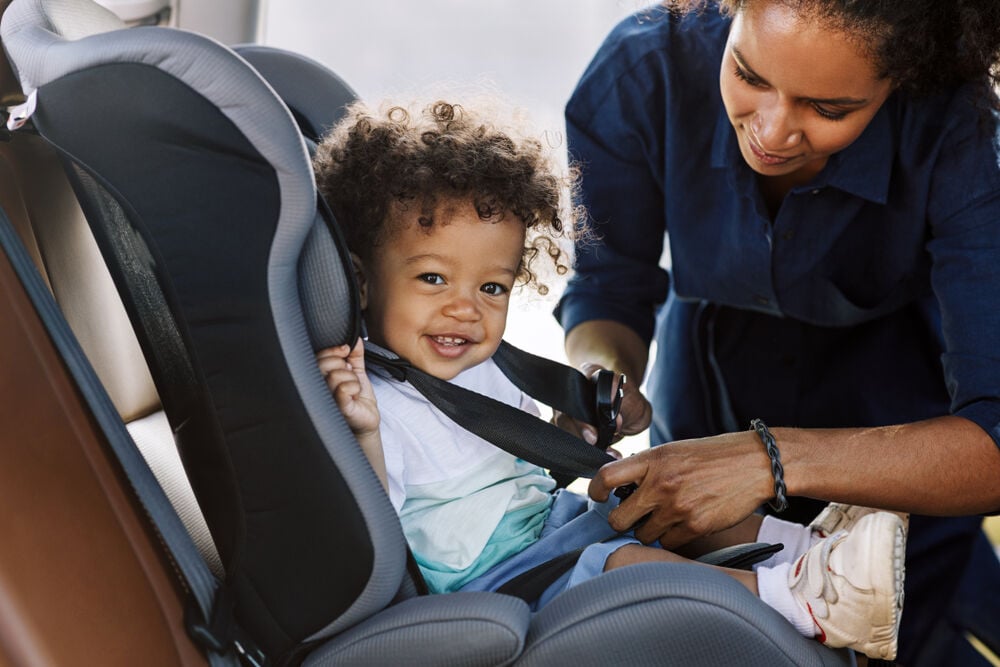If you’re a new or soon-to-be parent, you probably have a car seat on your list of newborn essentials. Since you’ll need one for many years to come, you are probably wondering when to change car seats. Read on to find the answer to that question and detailed descriptions of each car seat type.
-
Tracking cycle
-
Getting pregnant
-
Pregnancy
-
Help Center
-
Flo for Partners
-
Anonymous Mode
-
Flo app reviews
-
Flo Premium New
-
Secret Chats New
-
Symptom Checker New
-
Your cycle
-
Health 360°
-
Getting pregnant
-
Pregnancy
-
Being a mom
-
LGBTQ+
-
Quizzes
-
Ovulation calculator
-
hCG calculator
-
Pregnancy test calculator
-
Menstrual cycle calculator
-
Period calculator
-
Implantation calculator
-
Pregnancy weeks to months calculator
-
Pregnancy due date calculator
-
IVF and FET due date calculator
-
Due date calculator by ultrasound
-
Medical Affairs
-
Science & Research
-
Pass It On Project New
-
Privacy Portal
-
Press Center
-
Flo Accuracy
-
Careers
-
Contact Us
When to Change Car Seats: The Ultimate Cheat Sheet


Every piece of content at Flo Health adheres to the highest editorial standards for language, style, and medical accuracy. To learn what we do to deliver the best health and lifestyle insights to you, check out our content review principles.
Recommended car seat use for children under 12
A car seat is one of the most important newborn essentials. One of the biggest questions parents have is when to change car seats for their children. Car seats for children under 12 can be broken down into four types. Each kind of car seat has unique features and comes with specific guidelines for use. Read on to figure out which one is best for you!
Rear-facing infant seat

When it comes to choosing a car seat for your newborn, there are several options available. In addition to the rear-facing infant seat, there is also the convertible rear-facing seat, as well as the four-in-one, also called the all-in-one car seat. All three should be used in the rear-facing position until your child is about two years old.
Overall, many moms consider the infant seat as another kind of baby carrier. It gives them greater mobility and ease of travel than the convertible option.
Take a quiz
Find out what you can do with our Health Assistant
The most traditional and commonly used is the rear-facing infant seat, and there are several reasons for this. Rear-facing infant seats are used with a base, which is attached using either the lower anchors and tethers for children (LATCH) or seatbelt. This lets you take the infant car seat with you without having to disturb a sleeping baby. You can also purchase additional bases, letting you bring your baby in different vehicles without having to reinstall the car seat.
Rear-facing infant seats often fit with a coordinating stroller, making the transition between car seat and stroller a breeze. Overall, many moms consider the infant seat as another kind of baby carrier. It gives them greater mobility and ease of travel than the convertible option.
While the convertible rear-facing seat is another option for newborns, it doesn’t let you easily transfer your newborn like the infant seat can. The same is true for the all-in-one car seat, which is not mobile like the rear-facing. As its name suggests, the all-in-one car seat is meant to be the only car seat you need to buy.
While there are benefits to buying a car seat specifically for infants, it means you’ll have to purchase more car seats as your child grows. The convertible rear-facing seat is typically the next car seat you’ll use after the rear-facing infant seat. Most experts agree this switch should happen around the time of your baby’s first birthday.
Convertible rear-facing seat
A convertible rear-facing seat can be used in both rear- and forward-facing positions. It is typically purchased when your child is about one year old. According to experts, there are several reasons why this is the right time to switch from an infant seat to a convertible one.
Infant car seats typically have a weight limit of 22 pounds and a height limit of 30 inches.
A convertible rear-facing seat can be used in both rear- and forward-facing positions. It is typically purchased when your child is about one year old.
Many children will exceed either or both of these by the age of one. Yet, according to the Academy of American Pediatrics, children should stay in rear-facing car seats as long as possible, until they reach the highest weight or height allowed by their seat.
The solution is a convertible rear-facing seat. These car seats, which are used with a five-point restraint harness, can convert from rear to forward facing. They have higher weight and height limits, so they can keep your child in a rear-facing position longer. They also come with removable head and body cushions and adjustable strap positions.
Convertible forward-facing seat

When your child can no longer fit in a convertible rear-facing seat, it is time to switch to a convertible forward-facing seat. But when does this happen? It depends mostly on weight and height, but children will usually switch to a forward-facing seat when they’re around three to four years old. The nice thing about convertible forward-facing seats is that they can be used with a five-point harness or a seatbelt, when your child has reached booster seat age.
With the five-point harness system, you can use convertible forward-facing seats for children between 40 and 90 pounds. With a seatbelt, you can use them as a booster seat for children between 80 and 120 pounds. Forward-facing seats come with an adjustable back, and you can use the top tether for extra security.
Experts recommend that tethers be used as long as possible since they help keep your child’s head from moving too far forward in a car accident.
Tethers are straps that hold the car seat tightly in place. The top tether extends out from the back of the car seat to be connected to the vehicle’s anchor point. Anchor points are in different places depending on the car model; check the owner’s manual to locate them. Experts recommend that tethers be used as long as possible since they help keep your child’s head from moving too far forward in a car accident.
Belt-positioning booster
The fourth and final car seat you will need is the belt-positioning booster, a backless booster. You use these once your child has reached backless booster seat age, typically between 8 and 12 years old. This is also typically when they have exceeded the weight and height limits for the forward-facing car seat (4 feet 9 inches tall).
The fourth and final car seat you will need is the belt-positioning booster, a backless booster. You use these once your child has reached backless booster seat age, typically between 8 and 12 years old.
The belt-positioning booster raises the child’s height, allowing the seatbelt to fit snugly across their hips or upper thighs. Don’t forget to check that the shoulder belt fits across their shoulder and chest, not their neck or face. Typically, adult seats don’t fit well until children are between 8 and 12 years old. Because of this, a belt-positioning booster can be used all the way up until your child is 12 years old.
Other reasons to change your child’s seat
While a growing child is the main reason you’ll need to change car seats, there are some other situations or circumstances where a change might be necessary.
The child is too big for the car seat.
This is the most obvious reason to change your child’s seat. The first goal is to keep your child in the most protective type of seat available for their height and weight. Granted, this should not mean keeping them in a rear-facing seat if their heads are above the back of the car seat. But don’t be in a rush to move to the next car seat. The more protection against a crash or collision, the better.
The seat is damaged.
Though regular use will not typically damage car seats, it does occasionally happen. Dropping a car seat could result in damage. Car seats can also be damaged during flights, between check-in and baggage claim.
When it comes to situations like these, use good judgment. If it is a minor ding or dent, you might not need to replace the car seat. On the other hand, major damage will require that you find a new seat for your child.
The car seat has expired.
Car seats typically last up to six years, and there are valid reasons that they have expiration dates. Standards and technologies change. It’s not the end of the world to have an old version of a smartphone. Having a car seat without the most up-to-date safety standards, on the other hand, isn’t safe.
Seats are also only tested for safety for a certain period of time. This means that if you’re using an older car seat, it hasn’t been tested to modern standards, and you don’t really know how safe it is.
Having a car seat without the most up-to-date safety standards, on the other hand, isn’t safe. Seats are also only tested for safety for a certain period of time.
Expiration dates are usually located on the manufacturer’s label, found on the side or base of the seat.
The car seat has been in a crash.
Whether or not you need to replace a car seat after a crash depends on the severity of the crash. In a minor crash, you generally don’t need to replace the car seat.
But how do you know if your crash was minor or major? Fortunately, the National Highway Traffic Safety Administration has a specific list of what a minor accident looks like. If the vehicle and passengers are not hurt or damaged, there is a good chance you can still use the car seat.
Conclusion
While there are a lot of unknowns along the parenting journey, knowing when to change car seats doesn’t have to be one of them. Having an understanding of the types of car seats and when they need replacing helps you make the best possible choice for you and your child.


Hey, I'm Anique
I started using Flo app to track my period and ovulation because we wanted to have a baby.


The Flo app helped me learn about my body and spot ovulation signs during our conception journey.


I vividly
remember the day
that we switched
Flo into
Pregnancy Mode — it was
such a special
moment.
Real stories, real results
Learn how the Flo app became an amazing cheerleader for us on our conception journey.




